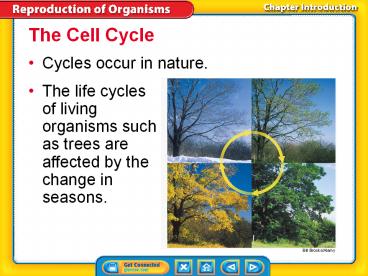Cycles occur in nature. - PowerPoint PPT Presentation
1 / 35
Title:
Cycles occur in nature.
Description:
The Cell Cycle Cycles occur in nature. The life cycles of living organisms such as trees are affected by the change in seasons. Bill Brooks/Alamy – PowerPoint PPT presentation
Number of Views:95
Avg rating:3.0/5.0
Title: Cycles occur in nature.
1
Lesson 1
The Cell Cycle
- Cycles occur in nature.
- The life cycles of living organisms such as
trees are affected by the change in seasons.
Bill Brooks/Alamy
2
Lesson 1
The Cell Cycle (cont.)
- Most cells in an organism go through a cycle of
growth, development, and division called the cell
cycle.
- There are two main phases in the cell
cycleinterphase and the mitotic phase.
3
A LIFE CYCLE
What would a human life cycle look like?
4
LETS MAKE. A FOLDABLE!
5
MITOSIS
MEIOSIS
Growth, development, and repair (asexual)
Sexual Reproduction
6
6.1 Chromosomes and Meiosis
- Humans have 23 pairs 46 chromosomes
Genes NOT related to sex of an organism.
Relate to sexual characteristics
7
Lesson 1
Different organisms have different numbers of
chromosomes.
8
Lesson 1
Interphase (cont.)
- The cells DNA is copied arranged as pairs of
identical chromosomes called sister chromatids.
- Sister chromatids are held together by a
structure called the centromere.
9
- You have two types of cells. Somatic (body) cells
and sex cells. What are the male and female sex
cells called?
10
6.1 Chromosomes and Meiosis
- Humans have 23 pairs 46 chromosomes
Genes NOT related to sex of an organism.
Relate to sexual characteristics
11
Lesson 1
46
46
46
12
Lesson 1
Haploid Cells
- Haploid cells are cells that have only one
chromosome from each pair of chromosomes.
haploid from Greek haploeides, means single
13
Lesson 1
Diploid Cells
- Organisms that reproduce sexually form body cells
and sex cells. - In body cells of most organisms, similar
chromosomes occur in pairs. - Pairs of chromosomes that have genes for the same
traits arranged in the same order are called
homologous chromosomes. - Diploid cells are cells that have pairs of
chromosomes.
14
Sex cells are ______________(haploid or diploid)
because they have _______ (46 or 23) chromosomes.
This is half the normal amount. Body cells are
_______________ (haploid or diploid) because they
have all ______ (46 or 23) chromosomes.
15
6.1 Chromosomes and Meiosis
- HAPLOID
DIPLOID
16
2n
MITOSIS
MEIOSIS
Growth, development, and repair (asexual)
Sexual reproduction
n
n
2n
2n
17
Lesson 1
Haploid Cells (cont.)
- In meiosis, one diploid cell divides and makes
four haploid sex cells. - Meiosis occurs only during the formation of sex
cells. - Meiosis involves two divisions, meiosis I and
meiosis II.
18
Lesson 1
What is sexual reproduction?
- Sexual reproduction is a type of reproduction in
which the genetic materials from two different
cells combine, producing an offspring. - The female sex cell, an egg, forms in an ovary.
- The male sex cell, a sperm, forms in the testis.
19
Lesson 1
What is sexual reproduction? (cont.)
During a process called fertilization, an egg
cell and a sperm cell join together to create a
zygote.
20
Lesson 2
What is asexual reproduction?
- In asexual reproduction, one parent organism
produces offspring.
21
- Plant pollination sexual or asexual?
BrainPOP Pollination
22
- Mitosis / meiosis CARD SORT!
23
- NOVA Interactive Animation
- http//www.pbs.org/wgbh/nova/body/how-cells-divide
.html
24
- Draw Mitosis and Meiosis stages in your foldable.
25
Lesson 1
The Phases of Meiosis (cont.)
- There are four phases of meiosis I.
26
Lesson 1
The Phases of Meiosis (cont.)
- There are four phases of meiosis II.
27
Lesson 1
Why is meiosis important? (cont.)
- The fertilized egg, formed when sex cells join
together, divides by mitosis to create a diploid
organism.
28
Lesson 1
Why is meiosis important? (cont.)
Why is meiosis important?
29
Lesson 1
How do mitosis and meiosis differ?
- During mitosis and cell division, a body cell and
its nucleus divide once and produce two identical
cells. - The two daughter cells produced by mitosis and
cell division have the same genetic
information.
30
Lesson 1
How do mitosis and meiosis differ? (cont.)
- During meiosis, a reproductive cell and its
nucleus divide twice and produce four cellstwo
pairs of identical haploid cells. - Meiosis forms sex cells used for sexual
reproduction.
31
Lesson 1
How do mitosis and meiosis differ?
- Create a Venn Diagram. With your partner, come up
with at least one thing for each category.
32
Lesson 1
Advantages of Sexual Reproduction
- Genetic variation occurs in all organisms that
reproduce sexually. - Due to genetic variation, individuals within a
population have slight differences.
33
Lesson 1
Advantages of Sexual Reproduction (cont.)
- Genetic variation may enable one plant to be more
disease-resistant than another within the same
species.
34
Lesson 1
Advantages of Sexual Reproduction (cont.)
- Selective breeding has been used to develop many
types of plants and animals with desirable traits.
Ingram Publishing/SuperStock
Stockbyte/Getty Images
Medioimages/PunchStock
image100/SuperStock
Wally Eberhart/Visuals Unlimited/Getty Images
35
Lesson 1
Disadvantages of Sexual Reproduction
- Organisms have to grow and develop until they are
mature enough to produce sex cells. - Organisms must form sex cellseither eggs or
sperm.































